
Newsletter of the
INTERNATIONAL ENVIRONMENT FORUM
Volume 17, Number 8 --- 15 August 2015
Website: iefworld.org
Article submission: newsletter@iefworld.org
Deadline next issue 13 September 2015
Secretariat Email: ief@iefworld.org General Secretary Emily Firth
Postal address: 12B Chemin de Maisonneuve, CH-1219 Chatelaine, Geneva, Switzerland
Download the pdf version
From the Editor, Request for information for upcoming newsletters
This newsletter is an opportunity for IEF members to share their experiences, activities, and initiatives that are taking place at the community level on environment, climate change and sustainability. All members are welcome to contribute information about related activities, upcoming conferences, news from like-minded organizations, recommended websites, book reviews, etc. Please send information to newsletter@iefworld.org.
Please share the Leaves newsletter and IEF membership information with family, friends and associates, and encourage interested persons to consider becoming a member of the IEF.
Consensus reached on new sustainable development agenda
The 193 Member States of the United Nations reached agreement on 2 August on the outcome document that will constitute the new sustainable development agenda that will be adopted this September by world leaders at the Sustainable Development Summit in New York.
Concluding a negotiating process that has spanned more than two years and has featured the unprecedented participation of civil society (including contributions by the International Environment Forum), countries agreed to an ambitious agenda that features 17 new Sustainable Development Goals that aim to end poverty, promote prosperity and people’s well-being while protecting the environment by 2030.
The agenda, including a declaration that covers implementation and review, required two weeks of negotiations and several all-night sessions to compete. There was a standing ovation and diplomats cheered when consensus was reached.
UN Secretary-General Ban Ki-moon welcomed the agreement, saying it “encompasses a universal, transformative and integrated agenda that heralds an historic turning point for our world.”
“This is the People’s Agenda, a plan of action for ending poverty in all its dimensions, irreversibly, everywhere, and leaving no one behind. It seeks to ensure peace and prosperity, and forge partnerships with people and planet at the core. The integrated, interlinked and indivisible 17 Sustainable Development Goals are the people’s goals and demonstrate the scale, universality and ambition of this new Agenda.”
Mr. Ban said the September Summit, where the new agenda will be adopted, “will chart a new era of Sustainable Development in which poverty will be eradicated, prosperity shared and the core drivers of climate change tackled.”
He added that the UN System stands ready to support the implementation of the new agenda, which builds on the successful outcome of the Third International Conference on Financing for Development in Addis Ababa, and which, he said, will also contribute to achieve a meaningful agreement in the COP21 in Paris in December.
More than 150 world leaders are expected to attend the Sustainable Development Summit at the UN headquarters in New York between 25 to 27 September to formally adopt the outcome document of the new sustainable agenda.
The new sustainable development agenda builds on the success of the Millennium Development Goals, which helped more than 700 million people escape poverty. The eight Millennium Development Goals, adopted in 2000, aimed at an array of issues that included slashing poverty, hunger, disease, gender inequality, and access to water and sanitation by 2015.
The new sustainable development goals, and the broader sustainability agenda, go much further, addressing the root causes of poverty and the universal need for development that works for all people.
The preamble of the 29-page text, “Transforming Our World: The 2030 Agenda for Sustainable Development,” states, “We are resolved to free the human race from the tyranny of poverty and want and to heal and secure our planet.” It continues, “We are determined to take the bold and transformative steps which are urgently needed to shift the world onto a sustainable and resilient path. As we embark on this collective journey, we pledge that no one will be left behind.”
Rio+20 and the intergovernmental process
At the Rio+20 Conference of 2012, Member States agreed to launch a process to develop a set of sustainable development goals, which will build upon the Millennium Development Goals. The Millennium Development Goals have proven that goal-setting can lift millions out of poverty, improve well-being and provide vast new opportunities for better lives. It was agreed that the new goals would be global in nature and universally applicable to all countries while taking into account different national realities, capacities and levels of development and respecting national policies and priorities.
The negotiations were co-facilitated by the UN Permanent Representative of Ireland, Ambassador David Donohue, and the UN Permanent Representative of Kenya, Ambassador Macharia Kamau, over two years. The inclusive and transparent consultations by Member States, with the strong engagement of civil society and other stakeholders, have served as a basis for the conclusion of the intergovernmental negotiations on the emerging universal and people-centred agenda.
Core elements of the agreed outcome document
The outcome document highlights poverty eradication as the overarching goal of the new development agenda and has at its core the integration of the economic, social and environmental dimensions of sustainable development. The emerging development agenda is unique in that it calls for action by all countries, poor, rich and middle-income. Member States pledge that as they embark on this collective journey, no one will be left behind. The ‘five Ps’—people, planet, prosperity, peace, and partnership—capture the broad scope of the agenda.
The 17 sustainable goals and 169 targets aim at tackling key systemic barriers to sustainable development such as inequality, unsustainable consumption and production patterns, inadequate infrastructure and lack of decent jobs. The environmental dimension of sustainable development is covered in the goals on oceans and marine resources and on ecosystems and biodiversity, bringing core issues into the goal and target framework.
The means of implementation outlined in the outcome document match its ambitious goals and focus on finance, technology and capacity development. In addition to a stand-alone goal on the means of implementation for the new agenda, specific means are tailored to each of the sustainable development goals.
Member States stressed that the desired transformations will require a departure from “business as usual” and that intensified international cooperation on many fronts will be required. The agenda calls for a revitalized, global partnership for sustainable development, including for multi-stakeholder partnerships. The agenda also calls for increased capacity-building and better data and statistics to measure sustainable development.
An effective follow-up and review architecture – a core element of the outcome document – will be critical to support the implementation of the new agenda. The High Level Political Forum on sustainable development, set up after the Rio+20 Conference, will serve as the apex forum for follow up and review and will thus play a central role. The General Assembly, the Economic and Social Council and specialized agencies will also be engaged in reviewing progress in specific areas.
Based on the outcome document, the agenda will include a Technology Facilitation Mechanism to support the new goals, based on multi-stakeholder collaboration between Member States, civil society, business, the scientific community, and the UN system of agencies. The Mechanism, which was agreed at the Addis Conference in July, will have an inter-agency task team, a forum on science, technology and innovation, and an on-line platform for collaboration.
The successful outcome of the Addis Conference gave important positive momentum to the last stretch of negotiations on the post-2015 development agenda. It is expected that the consensus reached on the outcome document will provide momentum for the negotiations on a new binding climate change treaty to culminate at the Climate Change Conference in Paris from 30 November to 11 December 2015.
This, of course, is only the beginning of an immense effort to implement such a complex and integrated set of global aspirations, including eradicating extreme poverty, reducing inequality within and between countries, moving to sustainability in water, energy, oceans, land and biodiversity management, and taking urgent action to combat climate change.
A new FINAL-FINAL version of the post-2015 summit outcome document was released on 12 August and can be downloaded at http://www.un.org/pga/wp-content/uploads/sites/3/2015/08/120815_outcome…
Source: updated based on UN article of 3 August 2015: http://www.un.org/en/development/desa/news/sustainable/sdg-consensus-re…
IEF planning for COP21 side events in Paris, December 2015
The IEF Board has submitted a request to host four side events in the civil society climate Generation areas, alongside the 21st Conference of the Parties to the United Nations Framework Convention on Climate Change (COP21) between 30 November and 11 December in Paris. The climate Generations areas, established by the French Government and open to the general public, are dedicated to civil society projects to help combat climate change and will host exhibitions and 150 conferences and debates throughout the two week period.
The IEF proposals have been developed in consultation with the Baha'i International Community in New York, and if accepted present an opportunity to engage a diverse audience in an interactive setting along the following themes:
Ensuring climate solutions work: ethical and spiritual principles for our shared responsibility
This participatory workshop will encourage the audience to explore their own values and their motivation to acknowledge their share of responsibility for implementing the Paris agreement and greenhouse gas reductions at their own level. The introductory panel will set the stage for facilitated small group discussions in both English and French.
Principles for accountability for climate change agreements
This workshop will explore the challenges of accountability in international governance in general and for the Paris outcomes in particular, and encourage all those present to consider the accountability mechanisms relevant to their own situations, including for governments, communities, the public, the media, and civil society organizations.
Community resilience in the face of climate-driven extreme events, a Vanuatu case study
Climate change adaptation requires increased resilience at the community level, and this workshop will use a case study of the island of Tanna, Vanuatu, hit by Cyclone Pam in March 2015, to discuss tools for building social cohesion at the rural village level, and more broadly in communities and neighbourhoods that are vulnerable to extreme climate events.
Values-based climate change education
This workshop will introduce approaches to values-based education developed by EU-funded research and networks, including toolkits for use in secondary schools. It will share the results of on-line and community courses in climate change education demonstrating the potential of interfaith approaches to climate change education.
The IEF Board will be advised in early September whether any or all of these proposals have been accepted.
Live sustainably to save the Earth
Sustainable Development and the Prosperity of Humankind
The Wilmette Institute is again offering its on-line course on Sustainable Development and the Prosperity of Humankind, originally developed for the Wilmette Institute by the International Environment Forum, and newly revised and updated this year. All the faculty are IEF members.
15 September - 2 November 2015 (7 weeks)
Faculty: Arthur Lyon Dahl, Gary Colliver, Carole Flood, Christine Muller
• Examine the wide agreement about the need to achieve sustainable development
• Seek to understand its profound implications for a prosperous human society
• Think about sustainability by integrating both the material and spiritual dimensions of life into a long-term systems perspective
• Apply that thinking to questions of everyday life and lifestyle
Review the economic, social, and environmental issues that humanity faces in achieving sustainability and explore the spiritual principles that can help us find solutions
Click here to Learn More About This Course
Fees: $80 for seniors, pioneers, and students; $100 for all other individuals; Groups: $150 for the first member, $30 each additional member ($180 for 2, $210 for 3, etc.)
10% discount for registration by August 27.
Plenty of scholarships are available; email wi@usbnc.org
Translation of Climate Change Course into French in Time for December UN Conference
Reprinted from the Wilmette Institute on-line Newsletter:
http://wilmetteinstitute.org/translation-of-climate-change-course-into-…
by Christine Muller
The Wilmette Institute’s course called Climate Change, first offered in February 2013, has existed since 2009 in a version similar to a Ruhi book. Called “Scientific and Spiritual Dimensions of Climate Change”, Christine Muller, lead faculty for the Wilmette Institute’s course, prepared the nine-unit class, which was posted on the website of the International Environment Forum (IEF), where it is still available. In 2012, when Dr. Robert H. Stockman, asked Christine to design a course for the Wilmette Institute, she based it on the IEF course, which she expanded, adding other topics and optional resources not available in the IEF course. Now the English Ruhi-format course has been translated into French by a collaborative effort involving seven translators residing in several countries. The new course is called “Les dimensions scientifiques et spirituelles du changement climatique.” Why, you may be asking, was so much effort put into a French translation? Christine shares her thoughts about that below.
—THE EDITORS, WILMETTE INSTITUTE
Humankind is finally waking up to the danger of a warming Earth with its devastating impacts on the climate now being experienced in all corners of the world. Droughts are becoming more severe; rainfall patterns are changing; and precipitation, floods, and storms are becoming more extreme. Reducing greenhouse gas emissions, the cause of the warming, is becoming more urgent because the window of opportunity to prevent a climate catastrophe is quickly closing.
International climate negotiations have been going on for decades, but bringing about major change on a global level has proven to be extremely difficult. Short-sighted national and corporate interests have so far obstructed global commitment to greenhouse-gas reduction that would be adequate to the threat.
From November 30 through December 11, 2015, France is hosting and presiding over the 21st Session of the Conference of the Parties to the United Nations Framework Convention on Climate Change (COP21), a very important international conference. The goal of COP21 is “to achieve a new international agreement on the climate, applicable to all countries, with the aim of keeping global warming below 2°C.” The stakes are high as time is fast running out to prevent a climate disaster. Therefore, climate change will be a major topic of discussion this fall everywhere, especially in France.
Because Bahá’ís are encouraged to apply the Bahá’í teachings in the public discourse of current issues, they felt it was necessary to have some educational materials about climate change available in French to offer to the general public and interfaith groups.
The new French version of the climate-change course, with five units, is designed for individual or group use and interfaith gatherings. The course covers the relationship of science and religion and introduces the basics on the causes and impacts of climate change. It then focuses on the spiritual and ethical teachings found in the Bahá’í Faith and other religions. These spiritual teachings are the foundation for the necessary fundamental transformation of our worldview and of our relationship with nature and with other human beings.
Public discourse by itself, though, is not sufficient and clearly needs to be accompanied by actions. Course participants discuss individual actions to reduce their own carbon footprint and what they can do as a community to tread lighter on the Earth. They also engage in simple service projects designed by themselves according to their interests and resources and especially attuned to the particular needs of their communities.
The objectives of the French and English climate-change courses are the same as those for Ruhi courses. As climate change is becoming a topic of general interest, the courses may be a way to engage new people in interfaith study circles. In Rhode Island, for example, a small interfaith group studied a draft version of the English course several years ago. After the group finished the course, one participant who was not a Bahá’í, asked whether there were any other study courses so she could continue to get together and have conversations. The group continued with Ruhi book 1, which led to her eventually becoming a Bahá’í. Seekers who are concerned about the environmental crisis are looking for spiritual solutions and will be attracted to a community that exemplifies in practical ways the spiritual teachings in terms of environmental responsibility.
The activities of the climate-change courses support and do not distract from Bahá’í core activities. Some participants of the English versions, both on the IEF website and the Wilmette Institute course, have been inspired to create devotionals on creation and the relationship of humankind with nature. Many are using their new insights in children’s and youth classes.
Other faith communities have also begun to see the moral dimensions of climate change and are taking action. Led by Interfaith Power and Light, many religious communities around the United States, for example, are committing to a 50 percent reduction in greenhouse-gas emissions by 2030 and to being carbon neutral by 2050. These steps are being taken to set an example for leaders in Paris as they make their carbon pledges.
The translation of the Bahá’í/interfaith course on climate change into French is one of many endeavors undertaken by the interfaith community to mitigate climate change.
The course is available on the IEF web site at: https://iefworld.org/ccFr0
World population projected to reach 9.7 billion by 2050
http://www.un.org/en/development/desa/newsletter/desanews/feature/2015/…
The current world population of 7.3 billion is expected to reach 8.5 billion by 2030, 9.7 billion in 2050 and 11.2 billion in 2100, according to the “World Population Prospects: The 2015 Revision”, launched on 29 July. “Understanding the demographic changes […], as well as the challenges and opportunities that they present for achieving sustainable development, is key to the design and implementation of the new development agenda,” said Wu Hongbo, UN DESA’s Under-Secretary-General.
Most of the projected increase in the world’s population can be attributed to a short list of high-fertility countries, mainly in Africa, or countries with already large populations.
During 2015-2050, half of the world’s population growth is expected to be concentrated in nine countries: India, Nigeria, Pakistan, Democratic Republic of the Congo, Ethiopia, United Republic of Tanzania, United States of America (USA), Indonesia and Uganda, listed according to the size of their contribution to the total growth.
“India expected to become the largest country in population size, surpassing China around 2022, while Nigeria could surpass the United States by 2050″
Shifts in the current population rankings
China and India remain the two largest countries in the world, each with more than 1 billion people, representing 19 and 18 % of the world’s population, respectively. But by 2022, the population of India is expected to surpass that of China.
Currently, among the ten largest countries in the world, one is in Africa (Nigeria), five are in Asia (Bangladesh, China, India, Indonesia, and Pakistan), two are in Latin America (Brazil and Mexico), one is in Northern America (USA), and one is in Europe (Russian Federation).
Of these, Nigeria’s population, currently the seventh largest in the world, is growing the most rapidly. Consequently, the population of Nigeria is projected to surpass that of the United States by about 2050, at which point it would become the third largest country in the world. By 2050, six countries are expected to exceed 300 million: China, India, Indonesia, Nigeria, Pakistan, and the USA.
Growing population in Africa
With the highest rate of population growth, Africa is expected to account for more than half of the world’s population growth between 2015 and 2050.
During this period, the populations of 28 African countries are projected to more than double, and by 2100, ten African countries are projected to have increased by at least a factor of five: Angola, Burundi, Democratic Republic of Congo, Malawi, Mali, Niger, Somalia, Uganda, United Republic of Tanzania and Zambia.
“The concentration of population growth in the poorest countries presents its own set of challenges, making it more difficult to eradicate poverty and inequality, to combat hunger and malnutrition, and to expand educational enrolment and health systems, all of which are crucial to the success of the new sustainable development agenda,” said John Wilmoth, Director of UN DESA’s Population Division.
While there is always some degree of uncertainty surrounding any projection, the large number of young people in Africa, who will reach adulthood in the coming years and start having children of their own, ensures that the region will play a central role in shaping the size and distribution of the world’s population over the coming decades.
Slower world population growth due to lower fertility rates
Future population growth is highly dependent on the path that future fertility will take, as relatively small changes in fertility behaviour, when projected over decades, can generate large differences in total population.
In recent years, fertility has declined in virtually all areas of the world, even in Africa where fertility levels remain the highest of any major area.
Ageing population growing rapidly
The slowdown in population growth, due to the overall reduction in fertility, causes the proportion of older persons to increase over time. Globally the number of persons aged 60 or above is expected to more than double by 2050 and more than triple by 2100.
A significant ageing of the population in the next several decades is projected for most regions of the world, starting with Europe where 34 % of the population is projected to be over 60 years old by 2050. In Latin America and the Caribbean and in Asia, the population will be transformed from having 11% to 12% of people over 60 years old today to more than 25% by 2050.
Africa has the youngest age distribution of any major area, but it is also projected to age rapidly, with the population aged 60 years or over rising from 5% today to 9% by 2050.
Higher life expectancy and the contribution of the MDGs
Life expectancy at birth has increased significantly in the least developed countries in recent years. The six-year average gain in life expectancy among the poorest countries, from 56 years in 2000-2005 to 62 years in 2010-2015, is roughly double the increase recorded for the rest of the world.
While significant differences in life expectancy across major areas and income groups are projected to continue, they are expected to diminish significantly by 2045-2050.
Progress in reducing under-five mortality, one of the Millennium Development Goals (MDGs) targets, has been very significant and wide-reaching in recent years.
Between 2000-2005 and 2010-2015, under-five mortality fell by more than 30% in 86 countries, of which 13 countries saw a decline of more than 50%. In the same time period, the rate decreased by more than 20% in 156 countries.
Young population creates opportunity to capture demographic dividend
Populations in many regions are still young. In Africa, children under age 15 account for 41% of the population in 2015 and young persons aged 15 to 24 account for a further 19%.
Latin America and the Caribbean and Asia, which have seen greater declines in fertility, have smaller percentages of children (26 and 24 %, respectively) and similar percentages of youth (17 and 16%, respectively). In total, these three regions are home to 1.7 billion children and 1.1 billion young persons in 2015.
These children and young people are future workers and parents, who can help to build a brighter future for their countries. Providing them with health care, education and employment opportunities, particularly in the poorest countries and groups, will be a critical focus of the new sustainable development agenda.
The 2015 Revision of World Population Prospects is the 24th round of official UN population estimates and projections that have been prepared by UN DESA’s Population Division.
For more information: World Population Prospects: 2015 Revision
The Freakish Year in Broken Climate Records
http://www.bloomberg.com/news/articles/2015-07-17/the-freakish-year-in-…
by Tom Randall, 17 July 2015, graphics from NOAA
The annual State of the Climate report is out, and it’s ugly. Record heat, record sea levels, more hot days and fewer cool nights, surging cyclones, unprecedented pollution, and rapidly diminishing glaciers.
The U.S. National Oceanic and Atmospheric Administration (NOAA) issues a report each year compiling the latest data gathered by 413 scientists from around the world. It’s 288 pages, but we’ll save you some time. Here’s a review, in six charts, of some of the climate highlights from 2014.
1. Temperatures set a new record
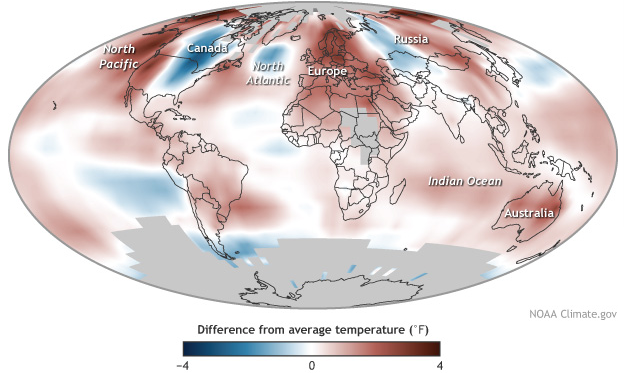
It’s getting hot out there. Four independent data sets show that last year was the hottest in 135 years of modern record keeping. The map above shows temperature departure from the norm. The eastern half of North America was one of the few cool spots on the planet.
2. Sea levels also surge to a record
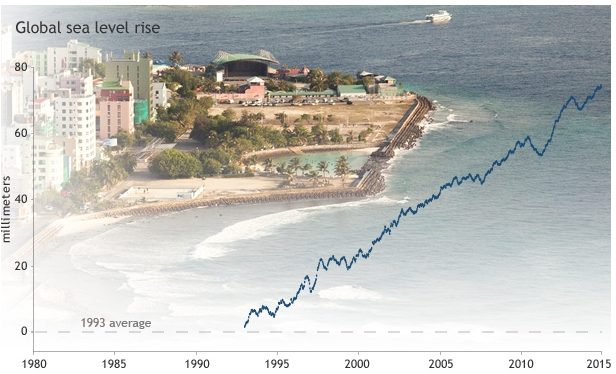
The global mean sea level continued to rise, keeping pace with a trend of 3.2 millimeters per year over the last two decades. The global satellite record goes back only to 1993, but the trend is clear and consistent. Rising tides are one of the most physically destructive aspects of climate change. Eight of the world’s 10 largest cities are near a coast, and 40 percent of the U.S. population lives in coastal areas, where the risk of flooding and erosion continues to rise.
3. Glaciers retreat for the 31st consecutive year
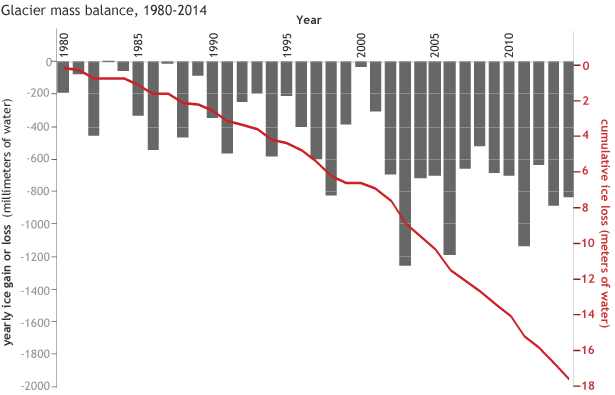
Data from more than three dozen mountain glaciers show that 2014 was the 31st straight year of glacier ice loss worldwide. The consistent retreat of glaciers is considered one of the clearest signals of global warming. Most alarming: The rate of loss is accelerating over time.
4. There are more hot days and fewer cool nights
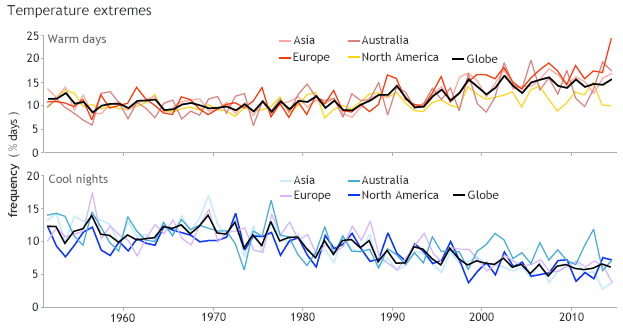
Climate change doesn’t just increase the average temperature — it also increases the extremes. The chart above shows when daily high temperatures max out above the 90th percentile and nightly lows fall below the lowest 10th percentile. The measures were near their global records last year, and the trend is consistently miserable.
5. Record greenhouse gases fill the atmosphere
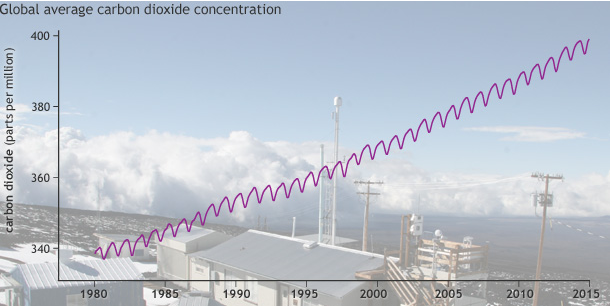
Photo of Mauna Loa Observatory in background. Source: NOAA
By burning fossil fuels, humans have cranked up concentrations of carbon dioxide in the atmosphere by more than 40 percent since the Industrial Revolution. Carbon dioxide, the most important greenhouse gas, reached a concentration of 400 parts per million for the first time in May 2013. Soon we’ll stop seeing concentrations that low ever again. The data shown are from the Mauna Loa Observatory in Hawaii. Data collection was started there by C. David Keeling of the Scripps Institution of Oceanography in March 1958. This chart is commonly referred to as the Keeling curve.
6. The oceans absorb crazy amounts of heat
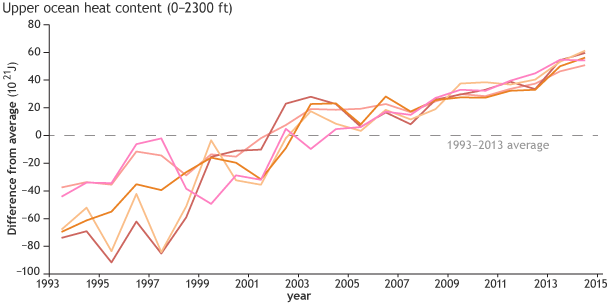
The oceans store and release heat on a massive scale. Over shorter spans of years to decades, ocean temperatures naturally fluctuate from climate patterns like El Niño and what’s known as the Pacific Decadal Oscillation. Longer term, oceans are absorbing even more global warming than the surface of the planet, contributing to rising seas, melting glaciers, and dying coral reefs and fish populations.
In 2015 the world has moved into an El Niño warming pattern in the Pacific Ocean. El Niño phases release some of the ocean’s stored heat into the atmosphere, causing weather shifts around the world. This El Niño hasn’t peaked yet, but by some measures it’s already the most extreme ever recorded for this time of year and could lead 2015 to break even more records than last year.
Updated 14 August 2015
|
